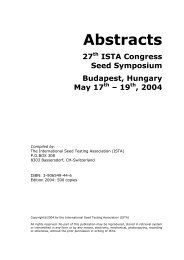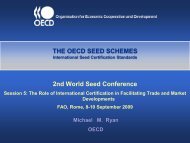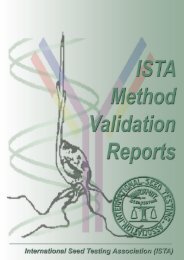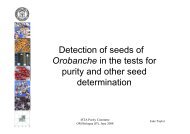Innovation in standard blowing procedures for Poa pratensis and ...
Innovation in standard blowing procedures for Poa pratensis and ...
Innovation in standard blowing procedures for Poa pratensis and ...
Create successful ePaper yourself
Turn your PDF publications into a flip-book with our unique Google optimized e-Paper software.
Oregon State University Seed Laboratory<br />
<strong>Innovation</strong>s <strong>in</strong> Uni<strong>for</strong>m Blow<strong>in</strong>g Procedure us<strong>in</strong>g<br />
Orchardgrass <strong>and</strong> Kentucky bluegrass as a model<br />
Adriel.Garay@oscs.orst.edu
Goals of presentation:<br />
ti<br />
• Importance <strong>and</strong> history of UBP<br />
• Problems encountered with previous system<br />
• Critical elements of new system<br />
• AOSA acceptance of new system<br />
• Use <strong>and</strong> ma<strong>in</strong>tenance of new system
Importance<br />
• Rapid purity method <strong>for</strong> estimat<strong>in</strong>g the percentage of<br />
<strong>in</strong>ert matter <strong>for</strong> certa<strong>in</strong> grass species.<br />
• Uni<strong>for</strong>mity is atta<strong>in</strong>ed through the elim<strong>in</strong>ation of<br />
personal ljudgment t<strong>in</strong> classify<strong>in</strong>g i florets <strong>in</strong>to pure seed<br />
<strong>and</strong> <strong>in</strong>ert components, <strong>and</strong> <strong>in</strong> reduc<strong>in</strong>g the variability of<br />
replicates <strong>for</strong> the germ<strong>in</strong>ation test.<br />
• Theoretically, results with<strong>in</strong> <strong>and</strong> among laboratories<br />
will be <strong>st<strong>and</strong>ard</strong>ized if blowers are properly calibrated.<br />
D. Meyer CDFA/PPDC 2006
History<br />
• 1961 - UBP officially adopted <strong>for</strong> use on Kentucky<br />
bluegrass.<br />
• 1976 – UBP added <strong>for</strong> orchardgrass, Pensacola<br />
bahiagrass, rough <strong>and</strong> Canada bluegrass.<br />
• 1982 - UBP added <strong>for</strong> blue grama <strong>and</strong> side-oats grama.<br />
• 2003 – UBP added <strong>for</strong> weep<strong>in</strong>g alkaligrass added.<br />
• 2006 – New blower calibration method accepted.<br />
D. Meyer CDFA/PPDC 2006
St<strong>and</strong>ard<br />
Calibration<br />
samples of<br />
Orchardgrass
General Blower
Purity Separation<br />
• Use the uni<strong>for</strong>m blow<strong>in</strong>g po<strong>in</strong>t established dur<strong>in</strong>g the<br />
calibration to set the blower air gate open<strong>in</strong>g.<br />
• Pure seed (heavy fraction) is separated from the <strong>in</strong>ert matter<br />
(light fraction) by air flow<strong>in</strong>g through the blower tube.<br />
Purity work<strong>in</strong>g sample<br />
of orchardgrass.<br />
After UBP, pure seed (heavy<br />
fraction) on left <strong>and</strong> <strong>in</strong>ert matter<br />
(light fraction) on right.<br />
D. Meyer CDFA/PPDC 2006
Problem !!!<br />
• The exist<strong>in</strong>g system did not provide<br />
checks <strong>and</strong> controls to verify uni<strong>for</strong>mity<br />
across labs or with<strong>in</strong> labs.<br />
• Some laboratories were us<strong>in</strong>g new<br />
calibration samples, while others were<br />
20+ years old.<br />
D. Meyer CDFA/PPDC 2006
Calibration Samples do Deteriorate<br />
• Seeds decay over time.<br />
• Frequency of use contribute to physical<br />
changes of the florets.<br />
• Physical changes, or loos<strong>in</strong>g critical sample<br />
components can have significant effects.<br />
D. Meyer CDFA/PPDC 2006
Problem!!!<br />
All previous factors can cause:<br />
Variation <strong>in</strong> physical properties p of seeds (term<strong>in</strong>al<br />
velocity)<br />
Variation among calibration samples is expected <strong>and</strong><br />
has been detected.<br />
Deviations among test results.<br />
D. Meyer CDFA/PPDC 2006
Assessment of KBG cal. samples.<br />
• 12 Kentucky bluegrass calibration samples obta<strong>in</strong>ed from<br />
various labs <strong>in</strong> the USA. Test replicated <strong>in</strong> three general<br />
blowers.<br />
D. Meyer CDFA/PPDC 2006
Assessment of OG cal. samples.<br />
12 orchardgrass calibration samples obta<strong>in</strong>ed from different<br />
labs with<strong>in</strong> the USA. Test replicated <strong>in</strong> three general<br />
blowers.<br />
D. Meyer CDFA/PPDC 2006
Conclusions about tOldS System<br />
• There was variation among calibration samples<br />
be<strong>in</strong>g used by laboratories<br />
• The system had no checks <strong>and</strong> controls to assure<br />
uni<strong>for</strong>mity across labs <strong>and</strong> through time.<br />
• There was an urgent need to improve the system.
Proposed Solution !!!!<br />
• Establish <strong>and</strong> ma<strong>in</strong>ta<strong>in</strong> a set of Uni<strong>for</strong>m Calibration Samples<br />
“Master Calibration Samples (MCS)”<br />
.<br />
• All laboratories would be required to use the “MCS” to f<strong>in</strong>d<br />
the correct sett<strong>in</strong>g <strong>in</strong> their blowers.<br />
• Once a blower calibration is established, the equivalent air<br />
velocity (EAV) would be measured.<br />
• The blower would be set to the EAV <strong>for</strong> each <strong>st<strong>and</strong>ard</strong><br />
blow<strong>in</strong>g procedure.<br />
• AOSA-USDA would ma<strong>in</strong>ta<strong>in</strong> the MCS.<br />
D. Meyer CDFA/PPDC 2006
General Blower
Requirement of the New System<br />
• Each laboratory need to<br />
purchase an anemometer to<br />
measure air velocity to<br />
monitor blower calibration.<br />
• Cost of recommended<br />
anemometer is ca. $ 160.<br />
D. Meyer CDFA/PPDC 2006
Anemometer<br />
<strong>in</strong>dicat<strong>in</strong>g air<br />
velocity of<br />
2.3 m/s <strong>in</strong><br />
General blower
Each Blower needs to be calibrated<br />
Air Velocity Profile of several General Blowers at the OSU Seedlab<br />
Blower ID<br />
Air open<strong>in</strong>g <strong>in</strong> blower 4 5 7<br />
Equivalent air velocity (EAV) <strong>in</strong> m/s<br />
10.0 2.1 1.5 1.5<br />
10.5 2.2 1.7 1.7<br />
11.0 2.4 1.8 1.8<br />
11.5 2.5 2.0 2.0<br />
12.0 2.6 2.1 2.2<br />
12.5 2.8 2.3 2.3<br />
13.0 2.9 2.4 2.5<br />
13.5 3.1 2.6 2.7<br />
14.0 3.2 2.7 2.9<br />
14.5 3.4 2.9 3.1<br />
15.0 35 3.5 31 3.1 33 3.3<br />
15.5 3.7 3.2 3.5<br />
16.0 3.8 3.4 3.7
Validation of New System
Validation Across Blowers<br />
Us<strong>in</strong>g 10 Orchardgrass Samples<br />
D. Meyer CDFA/PPDC 2006
Light <strong>in</strong>er rt blown (g)<br />
Separation of light-weight <strong>in</strong>ert <strong>in</strong> 3 bl<strong>in</strong>d Orchardgrass samples<br />
when labs used their own calibration samples<br />
0.40 ( referee across 8 laboratories, 10 blowers)<br />
0.35<br />
030 0.30<br />
0.25<br />
0.20<br />
0.15<br />
0.10<br />
005 0.05<br />
0.00<br />
1 2 3 4 5 6 7 8 9 10<br />
Laboratories<br />
Low <strong>in</strong>ert matter Medium <strong>in</strong>ert matter High <strong>in</strong>ert matter
0.40<br />
Separation of ligh-weight <strong>in</strong>ert <strong>in</strong> 3 bl<strong>in</strong>d Orchardgrass samples<br />
when labs used uni<strong>for</strong>m (master) calibration samples<br />
(referee across 8l laboratories, 10bl blowers)<br />
Light<br />
<strong>in</strong>ert bl lown (g)<br />
0.35<br />
0.30<br />
0.25<br />
0.20<br />
0.15<br />
0.10<br />
0.05<br />
0.00<br />
1 2 3 4 5 6 7 8 9 10<br />
Laboratories<br />
Low <strong>in</strong>ert matter Medium <strong>in</strong>ert matter High <strong>in</strong>ert matter
wn (g )<br />
g ht <strong>in</strong>e<br />
rt blo<br />
Li<br />
Comparison of blow<strong>in</strong>g 3 OG samples <strong>in</strong> 10 laboratories based on<br />
air velocity when blowers calibrated with own lab's calibration<br />
samples <strong>and</strong> master calibration samples<br />
04 0.4<br />
0.3<br />
0.2<br />
0.1<br />
0<br />
1 2 3 4 5 6 7 8 9 10<br />
Laboratories<br />
Low Inert - Lab Own Cal<br />
Medium Inert - Lab Own Cal<br />
High Inert - Lab Own Cal<br />
Low Inert - Master Cal<br />
Med Inert - Master Cal<br />
High Inert - Master Cal
Validation of uni<strong>for</strong>mity across<br />
blowers<br />
• Uni<strong>for</strong>m separation of pure seed <strong>and</strong> <strong>in</strong>ert matter of 5 Kentucky<br />
bluegrass samples with different levels of <strong>in</strong>ert matter content<br />
across 7 blowers us<strong>in</strong>g the air velocity calibration method.<br />
D. Meyer CDFA/PPDC 2006
separation of light-weight <strong>in</strong>ert <strong>in</strong> 3 Kentucky bluegrass samples<br />
when labs used their own calibration samples<br />
(referee across 8 laboratories, 10 blowers)<br />
Lig ht <strong>in</strong>ert b lo w n (g )<br />
0.06<br />
0.05<br />
0.04<br />
0.03<br />
0.02<br />
001 0.01<br />
0<br />
1 2 3 4 5 6 7 8 9 10<br />
Laboratories<br />
Low <strong>in</strong>ert matter Medium <strong>in</strong>ert matter High <strong>in</strong>ert matter
Acceptance by AOSA<br />
D. Meyer CDFA/PPDC 2006
H<strong>and</strong>book 24<br />
THE UNIFORM BLOWING PROCEDURE<br />
Contribution No. 24<br />
To The H<strong>and</strong>book On Seed Test<strong>in</strong>g<br />
Provides detailed<br />
<strong>in</strong>structions on blowers,<br />
calibration samples,<br />
calibration <strong>procedures</strong><br />
<strong>and</strong> dthe UBP.<br />
Published by the<br />
ASSOCIATION OF OFFICIAL SEED ANALYSTS<br />
1962<br />
Revised<br />
1978<br />
Revised 1983<br />
Revised 2004<br />
Revised 2006<br />
D. Meyer CDFA/PPDC 2006
Blower Calibration<br />
The rule only applies to the<br />
General Blower.<br />
D. Meyer CDFA/PPDC 2006
Blower Calibration<br />
Master<br />
Calibration<br />
Sample<br />
Storage<br />
Pre-condition<strong>in</strong>g<br />
D. Meyer CDFA/PPDC 2006
Blower Calibration<br />
ato<br />
Light fraction<br />
Heavy fraction<br />
Set gate open<strong>in</strong>g<br />
Entire sample<br />
<strong>in</strong> blower cup<br />
Blow sample<br />
exactly 3 m<strong>in</strong>.<br />
Count the<br />
displaced seed<br />
D. Meyer CDFA/PPDC 2006
Blower Calibration Review<br />
Blower Sett<strong>in</strong>g<br />
Trial number<br />
Light florets <strong>in</strong><br />
heavy fraction<br />
Heavy florets <strong>in</strong><br />
light fraction<br />
1 11 3<br />
12.00 2 13 5<br />
12.10<br />
3 15 3<br />
Average 13 4<br />
1 7 8<br />
2 7 5<br />
3 6 3<br />
Average 7 5<br />
1 4 13<br />
12.2020<br />
2 5 15<br />
3 1 9<br />
Average 3 12<br />
D. Meyer CDFA/PPDC 2006
Blower Calibration<br />
How to Measure Air Velocity<br />
• Establish optimum blow<strong>in</strong>g<br />
po<strong>in</strong>t based on the “Master”<br />
calibration sample.<br />
• Set air gate open<strong>in</strong>g at the<br />
optimum blow<strong>in</strong>g po<strong>in</strong>t.<br />
• Remove the blower cup <strong>and</strong><br />
center the anemometer fan<br />
over the open<strong>in</strong>g at the base<br />
of the blower.<br />
D. Meyer CDFA/PPDC 2006
Blower Calibration<br />
How to Measure Air Velocity<br />
• Turn anemometer on; set to measure<br />
meters/second.<br />
• Turn blower on <strong>and</strong> run <strong>for</strong> 30 – 60 seconds.<br />
• When digital read-out stabilizes record<br />
read<strong>in</strong>g.<br />
• This air velocity is the “equivalent air velocity<br />
value.”<br />
D. Meyer CDFA/PPDC 2006
Blower Calibration<br />
How to Measure Air Velocity<br />
When the UBP is used<br />
on the purity work<strong>in</strong>g<br />
sample the gate<br />
open<strong>in</strong>g is adjusted to<br />
match the equivalent<br />
air velocity value<br />
established dur<strong>in</strong>g the<br />
calibration <strong>for</strong> the k<strong>in</strong>d<br />
of seed be<strong>in</strong>g tested.<br />
This sett<strong>in</strong>g will be<br />
blower specific!<br />
D. Meyer CDFA/PPDC 2006
Species Without a Master<br />
Calibration Sample<br />
• Determ<strong>in</strong>e the optimum calibration po<strong>in</strong>t <strong>for</strong> Kentucky<br />
bluegrass as previous described.<br />
• The blower gate open<strong>in</strong>g value <strong>for</strong> this po<strong>in</strong>t shall be<br />
multiplied by the appropriate factor <strong>for</strong> the k<strong>in</strong>d of<br />
seed be<strong>in</strong>g tested.<br />
• Adjust blower gate open<strong>in</strong>g to the new value.<br />
• Measure the equivalent air velocity value <strong>for</strong> the<br />
adjusted gate open<strong>in</strong>g.<br />
D. Meyer CDFA/PPDC 2006
Advantages of Us<strong>in</strong>g<br />
Master Calibration Samples<br />
• The Federal Lab adm<strong>in</strong>isters i the MCS on loan to any<br />
AOSA-SCST Lab. This lab tracks the uni<strong>for</strong>mity constantly.<br />
• Member Labs don’t need to purchase a calibration sample<br />
any more.<br />
• The system <strong>in</strong>creases repeatability among laboratories that<br />
use the Master Calibration Samples.<br />
• It presents a model that can be used <strong>in</strong> other species.<br />
D. Meyer CDFA/PPDC 2006
Advantages of us<strong>in</strong>g<br />
Equivalent Air Velocity<br />
The EAV is the causal factor of the desired seed separation.<br />
Once identified, the EAV is a fixed po<strong>in</strong>t <strong>in</strong> each <strong>in</strong>dividual blower<br />
The EAV changes only with change of glass tube or major repair.<br />
The use of EAV reduces the repeated use <strong>and</strong> deterioration of<br />
MCS !<br />
Creates simplicity <strong>for</strong> daily monitor<strong>in</strong>g of UBP!
Acknowledgements:<br />
Oregon Seed Council <strong>and</strong> Oregon Department of Agriculture<br />
<strong>for</strong> their f<strong>in</strong>ancial support<br />
Northwest seed test<strong>in</strong>g laboratories, AOSA <strong>and</strong> SCST <strong>for</strong> their<br />
suggestions <strong>and</strong> participation<br />
Laboratories that participated p <strong>in</strong> refereed research<br />
OSU Seed Laboratory staff <strong>for</strong> their constant research ef<strong>for</strong>t.

















